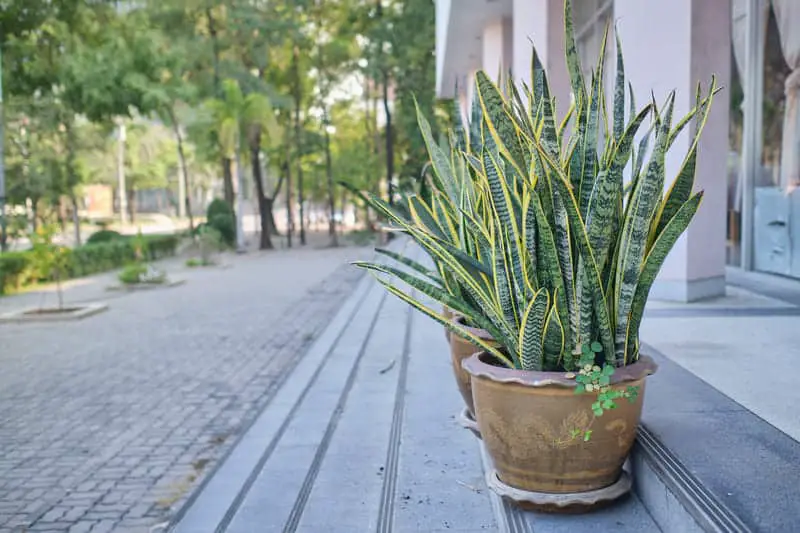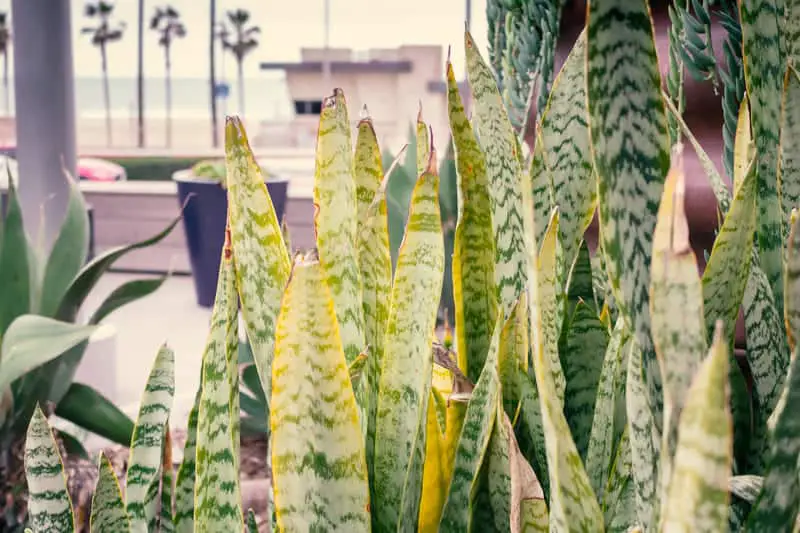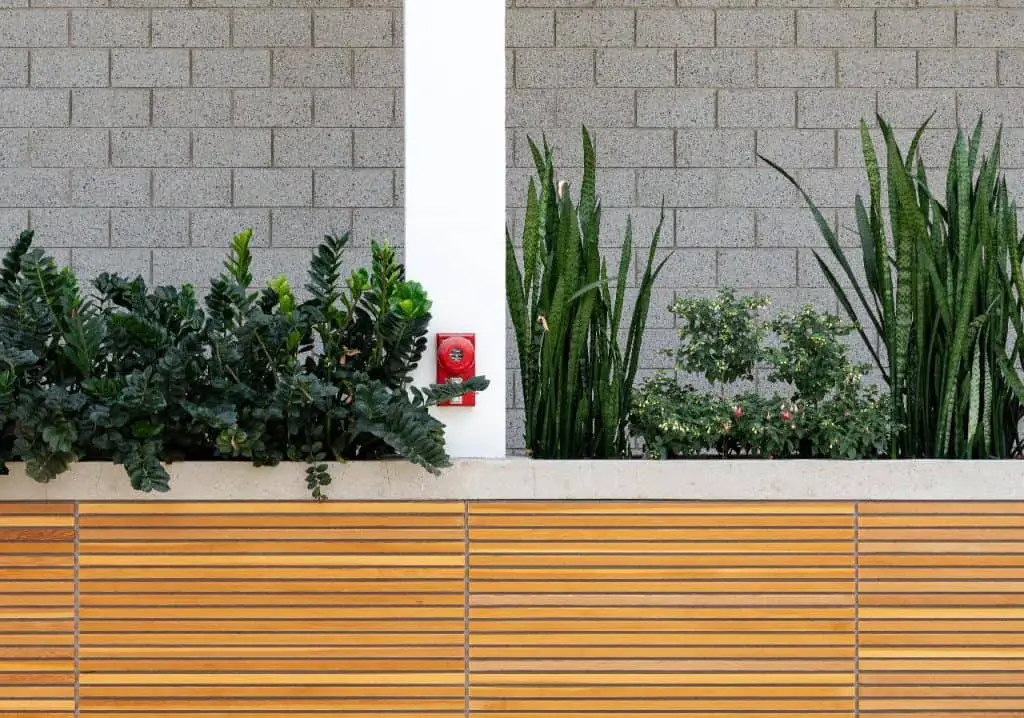Snake plants or “Mother in Laws Tongue” plants are common and easy to care for house plants due to their low requirements for both light and water.
Even though these plants are considered “easy”, they can still suffer from a variety of issues, such as yellowing leaves, if not properly cared for.
Yellow leaves on a snake plant can result from over-watering, under-watering, or insufficient light. These causes can lead to root rot, stress, or poor health in the plant.
There are a few reasons why your snake plant might be turning yellow, including:
- Watering stress
- Root rot
- Changes in temperature or exposure to extreme temperatures
- An increase in the amount of direct sunlight
- Pests or fungal diseases
- Insufficient nutrients
Digging deeper into the current care and growing conditions for your plant can help reveal what the issue might be. Then, some fairly minor adjustments should be enough to get your snake plant back on track!

Read on to learn more about how to properly care for your snake plant when it starts turning yellow!
What do I do when my snake plant turns yellow?
When you start to see signs of stress in your snake plant, such as the leaves turning yellow, you need to seriously consider the conditions it is growing in.
1. Watering Stress
Think about how often your snake plant is being watered. They don’t require water too frequently, and the top few inches of soil should be fully dry before you need to water them again.
The exact frequency can vary depending on where you live, how much sun exposure the plant gets, the pot the plant is in, and the humidity in your home. Usually, this is about once every 2 weeks.
Although snake plants do not require frequent watering, you should thoroughly water your plant when you do so. Water enough that all the soil becomes saturated, and allow any excess water to drain out of the bottom of the pot. This will ensure that:
- Your plant does not develop issues from overwatering and sitting in standing water and,
- Your plant’s roots do not dry up and die back from lack of water. This can happen if you only add a little water to the pot each time.
Also check: How Often Should You Water a Snake Plant?
2. Root Rot
Poor drainage in your pot, caused by using the wrong soil for your plant, may cause root rot which in turn causes yellow leaves to develop.
Snake plants require well-draining soil in order to thrive. Usually, a light, loamy mix of potting soil, perlite, and peat moss or coconut coir works well.
Regular indoor plant mix may become compacted and be too dense, making it difficult for water to drain out and roots to grow.
If you suspect your plant is suffering from root rot, gently remove the soil from the roots and cut off any black or mushy roots from the plant.
Repot your snake plant into suitable, well-draining soil and ensure the pot you use has sufficient drainage holes in the bottom.
3. Temperature
Snake plants are naturally found in tropical western Africa, so they are not likely to tolerate long periods of colder temperatures.
Whether inside or planted outside, your snake plant will be happiest if temperatures remain above 10 degrees Celsius (about 50 Fahrenheit).
If temperatures are regularly dropping to 10 degrees Celsius or lower, your plant will start to develop yellow leaves and should be moved somewhere that is consistently warmer.
Be mindful of plant placement inside as well, as plants near windows in the winter may suffer due to cooler temperatures and cold drafts.
4. Sunlight
Although originally from parts of Africa, your snake plant is still sensitive to sunlight. This is because snake plants are understory plants that grow on the forest floor under the taller canopy.
This means they are not often exposed to full sun, and instead have shady to partially sunny conditions naturally. Because of this, your snake plant might develop yellow or browning leaves from sun damage if it is placed in an area with too much full sun.
If you think your plant is receiving too much direct sunlight, relocate it to an area with less sun and allow it time to adjust to the new conditions.
Also check: Can Snake Plants Live Outside?
5. Pests
Just like any indoor house plant, a snake plant can suffer from a variety of pests and diseases. As a succulent, these plants are especially prone to pests that are “suckers” that target the sap inside the thick leaves.
For snake plants, this usually includes mealy bugs and spider mites. Comparison and treatment for these two pests are summarized below.
| Pest | Indicators | Description | General Treatment | Insecticide | Biological Control |
| Mealy Bugs | Yellow and dying leaves, cotton/waxy deposits on leaves, black sooty mold | Small, flat, oval bugs with a waxy white or powdered appearance | Hand picking or dabbing with alcohol to remove from the plant | Neem oil, other general insecticide | Various ladybird beetles |
| Spider Mites | White or yellow spots on leaves, silky webs on leaves, yellowing leaves | Small, oval bugs light to dark green in colour | Gently wash off mites from the plant and increase humidity by spraying occasionally | Neem oil, other general insecticide | Predatory mite and gall midge species |
6. Nutrients
Finally, insufficient or excessive amounts of certain nutrients may cause your snake plant leaves to turn yellow.
This can usually be corrected by applying a fertilizer prior to or near the start of the growing season. Be sure to properly follow the fertilizer instructions to avoid shocking your plant.
Can yellow snake plant leaves turn green again?
Yellowing of snake plant leaves often means the plant is stressed or unhappy in some way. In some cases, the actual leaf is dying, such as in situations of overwatering or root rot.
Alternatively, the leaf might be damaged in some way, such as by exposure to direct sunlight causing sunburn. In either instance, it is unlikely that a yellow snake leaf will turn green again.
The plant will be more focused on storing energy and nutrients and roots while it is stressed, and on growing new leaves once conditions are more favourable.
A leaf that is already dying off will be a low priority for your plant, so it will likely continue to die even after you correct the issue your plant is suffering from.
What does an overwatered snake plant look like?
Snake plants may suffer from overwatering if they are not left to properly dry out between waterings, or if poor drainage due to improper potting (without drainage holes) or poor soil causes roots to sit in standing water for extended periods.
Healthy, properly watered plant roots will be crisp, firm, and light brown to white in colour. Roots suffering from root rot will be dark brown or black and soft or mushy in comparison.
Snake plant leaves will become yellow and soft if the plant is overwatered. The leaves might also become wilted or develop soft, brown spots near the base.
Finally, an overwatered plant will still have soft, wet soil days after the last watering, indicating poor drainage in your pot or lack of absorption by the roots.
Are yellow snake plant leaves normal?
It is important to remember that some yellow present on snake leaves can be expected. First of all, yellowing or dying leaves might be part of the natural aging of the plant.
Some older leaves die off to allow younger leaves to take their place. When too many yellow leaves appear on a plant, however, it impacts the ability of the plant to photosynthesize and may indicate an issue with the health.
Snake plants can also be part of the “variegated” variety. The leaves of variegated snake plants are often bordered with yellow edges.
These yellow edges can vary in size, and it might appear that your plant’s leaves are yellowing when in fact they are just variegated! If your plant seems otherwise healthy and the leaves are not brown, soft, or wilting, you probably don’t have a reason to be concerned.
Snake plant turning yellow and crispy
Snake plant leaves that are turning yellow and crispy at the top (as opposed to yellow and soft or mushy) are most likely suffering from underwatering and/or a lack of humidity.
As tropical plants, snake plants require a certain level of humidity in the air to be happy. If the air is too dry, the leaves will start to dry out.
To improve humidity around your plant, you can use a small, portable humidifier you regularly add water to.
You could also mist or spray the area around the plant with a spray bottle, however, you want to be careful about misting the plant directly.
If water droplets are allowed to remain on your plants leaves for too long, they can cause rotting and other issues.
If you think your air is humid enough and you still have dry or crispy leaves, you might be underwatering your plant.
Remember that although snake plants don’t require watering very frequently, watering your plant on a regular schedule and thoroughly each time it important for its health.
Your plant should be watered about once every 2 weeks, once the top few inches of soil is fully dry. Leaving your plant dry for too long can allow roots to dry up and die off, harming your plant.
When you water your plant, water it fully so all the soil becomes wet, and allow excess water to drain out properly. Following these tips should prevent your plant from suffering from underwatering and developing dry leaves.
Snake plant turning yellow from bottom
If your snake plant leaves are only turning yellow at the base, this can help you narrow down the cause. This most likely occurs due to:
- Slow-draining soils,
- Overwatering, or
- Cold temperatures
Before you can remedy these issues, you have to first assess your plants care to determine what the cause is.
Once you narrow down the cause, making some minor adjustments to the care following the recommendations listed above should help to restore your snake plant to its previous health.
Keep in mind that it likely took an extended time of poor care for your plant to develop yellow leaves, and so it will take time for your plant to adjust to new conditions as well.
If yellow leaves continue to appear on your plant after an extended time, you should reassess your plant’s care and ensure that something else isn’t the cause.
Should I remove yellow leaves from snake plant?
Yellow and dying leaves can take away from the aesthetics of your plant, and you may want to remove them as a quick way to get your plant to look healthy again.
Cutting leaves or any part of your house plants can be stressful since you don’t want to do more damage to your plant, so knowing how to properly do so to keep your plant healthy is essential.
If leaves are soft, yellow, brown, or black in colour this is likely due to rot. Leaves that are rotting should be trimmed back to prevent rot from spreading to other areas of the plant and to promote new growth.
Leaves that are dry, brown, and crispy on the edges are more likely due to underwatering. These are less essential to be removed, and if the majority of the leaves on the plant are dry, it might be too stressful to the plant to remove them all at once.
You might start by removing a few of the leaves that are brown to promote new growth. Once new leaves start growing, you can remove a few more brown leaves until all your leaves are healthy.
Finally, leaves that are yellow from pests or diseases should be treated with special care. Depending on the issue, you might expose your plant to additional problems by cutting off leaves.
There is a balance between preventing the spread of disease and making it worse. Researching your specific issue can help you make this choice.
Once you decide to remove leaves from your plant, be sure to use sharp, clean shears to make cuts close to the base of the leaf.
Remove plant material fully and dispose of it, don’t allow it to decompose on the top of the soil as that can promote additional rot and disease in the plant.


